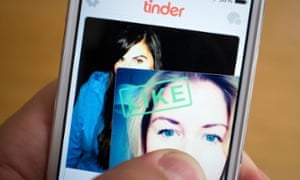
Dating app Tinder has rejected research that estimated that 42% of its users are either married or in a relationship.
A spokesman told the Guardian that the figures by GlobalWebIndex strongly contradicted its own internal numbers, and criticised the methodology of the survey.
“The results of this tiny, 681 person study in the UK is a totally inaccurate depiction of Tinder’s user base – this firm is making guesses without having any access to real data on our millions of users worldwide,” said the spokesperson.
Is it “essentially impossible” for GWI’s claims to be accurate? If 30% of Tinder users were married, it is theoretically possible for them to fall into the nearly half of the app’s users that are older than 24, by Tinder’s own figures.
This, however, would indicate that nearly 60% of Tinder’s over 24-year-old users are married, which seems unlikely. It is unclear whether Tinder’s “user base” figures refer to active or registered users, which may also have an impact on the data.
GlobalWebIndex has defended its methodology, in its own statement provided to the Guardian.
“GlobalWebIndex data is based on interviews with a panel of more than 170,000 internet users worldwide, the largest on-going study into the digital consumer - it’s not guesswork, and not just the UK, as Tinder has suggested,” said GWI’s spokesperson.
“More than 50% of Tinder’s userbase is age 18-24. And altogether, 85% of our users are age 18-34.” A statement that was not so out of kilter with GWI’s claim that 83% of Tinder users are aged between 16 and 34.
It’s the image of Tinder as a hookup app for people who already have partners that appears to be most concerning the company, however.
Throughout its history, Tinder has maintained that it is not just for arranging sex – or even for dating – preferring to pitch itself as “a social network” that people use for platonic reasons too.
A spokesman told the Guardian that the figures by GlobalWebIndex strongly contradicted its own internal numbers, and criticised the methodology of the survey.
“The results of this tiny, 681 person study in the UK is a totally inaccurate depiction of Tinder’s user base – this firm is making guesses without having any access to real data on our millions of users worldwide,” said the spokesperson.
GWI’s report claimed that 38% of Tinder’s users were aged between 16 and 24, while another 45% were aged between 25 and 34. It also suggested that 30% of Tinder users that it surveyed were married, while another 12% were in a relationship.The single largest age group on Tinder, making up more than half of our entire user base, is 18-24. More than 93% of UK residents in that age range have never been married, according to the UK’s office of National Statistics.
Without revealing any data about our users, simple logic should reveal that it’s essentially impossible for any of these claims to be accurate. Their methodology seems severely and fundamentally flawed.”
Is it “essentially impossible” for GWI’s claims to be accurate? If 30% of Tinder users were married, it is theoretically possible for them to fall into the nearly half of the app’s users that are older than 24, by Tinder’s own figures.
This, however, would indicate that nearly 60% of Tinder’s over 24-year-old users are married, which seems unlikely. It is unclear whether Tinder’s “user base” figures refer to active or registered users, which may also have an impact on the data.
GlobalWebIndex has defended its methodology, in its own statement provided to the Guardian.
“GlobalWebIndex data is based on interviews with a panel of more than 170,000 internet users worldwide, the largest on-going study into the digital consumer - it’s not guesswork, and not just the UK, as Tinder has suggested,” said GWI’s spokesperson.
The new statement from Tinder follows its separate rebuttal to the original report, when another spokesperson told the Guardian that “those statistics are completely inaccurate. I’m not sure how they sampled that specific group of people, but it does not represent Tinder’s user base”.“Our Tinder findings came from a recent study of 47,622 internet users aged 16-64 across 33 countries.
Reference to ONS marital data is irrelevant, and of the 621 who say they use Tinder, almost all are from the 16-34 age group. Tinder’s assertion that our methodology is severely and fundamentally flawed is simply not correct.
We only publish statistically robust numbers, and self-reported survey data is widely recognised as an effective way of understanding consumer behaviour.”
“More than 50% of Tinder’s userbase is age 18-24. And altogether, 85% of our users are age 18-34.” A statement that was not so out of kilter with GWI’s claim that 83% of Tinder users are aged between 16 and 34.
It’s the image of Tinder as a hookup app for people who already have partners that appears to be most concerning the company, however.
Throughout its history, Tinder has maintained that it is not just for arranging sex – or even for dating – preferring to pitch itself as “a social network” that people use for platonic reasons too.
Posting Komentar